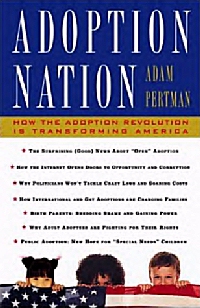
Adoption Nation:
How the Adoption Revolution is Transforming America
by Adam Pertman
Basic Books, 2000
Reviewed by Barbara Free
At the beginning of the book, Pertman states, “After a long period of warning tremors, adoption is ‘changing’ like a simmering volcano changes when it can no longer contain its explosive energy.” Quoting statistics gathered by the Evan B. Donaldson Adoption Institute of New York, he says that their survey showed nearly six of every ten Americans have had a “personal experience with adoption,” meaning that either they or a family member or close friend were adopted, had adopted, or had relinquished a child for adoption. One-third of those in the survey said they had “at least somewhat seriously” considered adopting a child themselves. These figures are probably lower than the reality, since some adoptees still don’t know they are adopted, some birth parents will not answer truthfully out of shame and fear, and some adoptees do not know step-parent adoption is still adoption. In other words, most people in our culture have some adoption connections, and therefore have opinions and attitudes, as a result of their experiences.
We are living in a time of changing policies and attitudes, which are changing ways of conducting adoption, and also changing the ways in which people deal with the life-long consequences of adoption. The “child as product” attitudes still persists, but instead of orphan trains, we have very expensive adoptions, Internet pictures of children, and adoption “picnics,” where prospective adoptive parents can look over the children available. The constant that we must remember is that, as the author states, “nearly all adoptions are initiated by women and men suffering from heartbreak and loss.” He also states, “Perpetuating the myth of ‘everybody wins’ can impede progress because it trivializes or even ignores the feelings of grief, insecurity, and identity confusion that are integral components of adoption, for adoptees as well as their two sets of parents.”
This book explores issues from the perspectives of birth parents and adoptees, as well as adoptive parents. The author discusses the legal and emotional issues, open records, open adoption, reunion, legislative changes, financial realities, state registries, and a proposed national registry.
An interesting fact is that, in the nineteenth century, foundling homes in New York funded research to develop infant formulas, due to a shortage of wet nurses available to feed the babies in such homes. That was supposed to be the magic answer to what was considered a great social problem!
In the 1950s, Korean War orphans became the first large national group of adoptees for Americans. Because of their arrival in white families, people began to be more open about telling adoptees they were adopted, since these children obviously did not look like the adoptive parents. The telling spilled over to other adoptees, but still, no more information was given to them, such as their true family history. Such a thing as open adoption was only heard of in a few in-family adoptions. Now, open adoption is becoming common, with open adoption visitation agreements being legally binding in a few states, including New Mexico, where they can always be amended by the two sets of parents. The Pertmans’ children have different degrees of closeness in their relationships with their birth families. The author states that “the earlier extended relationships are formed, the easier the adjustment and the greater the benefits” for all concerned.
While open adoption is not so possible with international adoptions, the book reports that Americans adopt more children internationally than do inhabitants of the rest of the planet combined, possibly because this a nation of immigrants. The push to “assimilate” is giving way to a philosophy of retaining a child’s cultural identity. Holt International was the first agency to handle large numbers of international adoptions, starting with the Korean babies, and now the large numbers of children from Eastern Europe and China.
This book also tells personal stories of relinquishment in sensitive ways, and notes that birth parents, in the past, have not been able to acknowledge their grief and loss. The author uncovered some amazing stories of connections and healing in families. He also discusses the current spate of “baby-dumping” laws; the trend of adoption by single adults, gay couples or singles; the use of advertising, picnics, newspaper stories, and Internet ads; and the complicated situations brought about by donor egg and sperm, surrogates, and other assisted technologies. Until recently, these were not considered adoption issues. With the trend toward openness and truth, and the availability of DNA testing, the adoption reform community has seen the relevance of these issues.
This reviewer highly recommends this book, which is well-written, and full of engaging examples as well as facts.
Excerpted from the October 2001 edition of the Operation Identity Newsletter
© 2001 Operation Identity